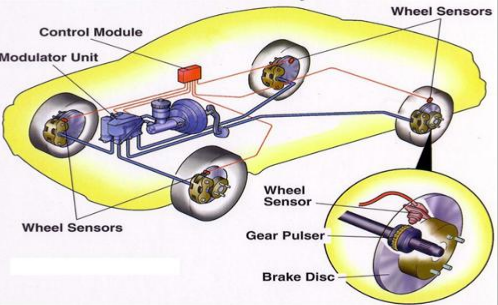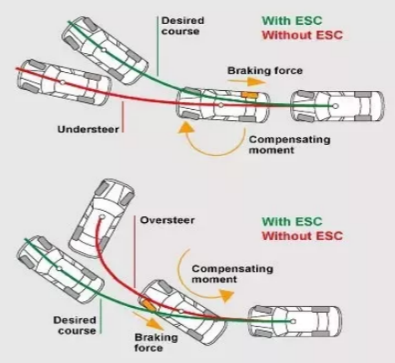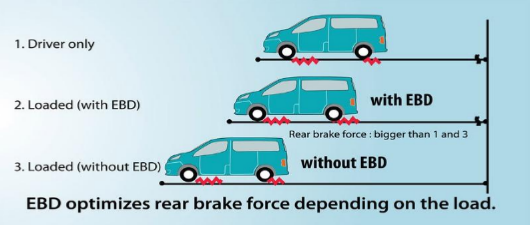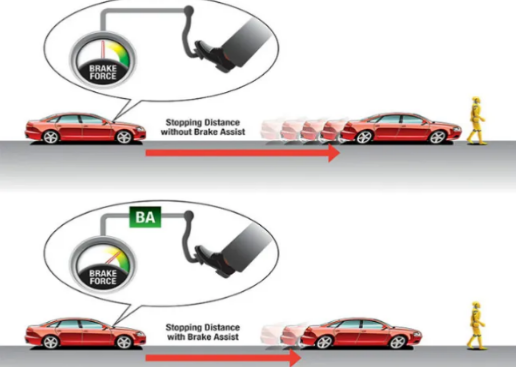ABS prevents wheel lock-up during hard braking, ensuring steering control, while EBS optimizes brake force distribution based on wheel load and conditions.
Introduction
Vehicle braking systems have undergone significant evolution, largely driven by advances in technology and the ever-increasing demand for safer and more efficient road transport. Today, with the rise of automated vehicles and smart transport infrastructure, the role of advanced braking technologies has never been more critical.

Background of Vehicle Braking Systems
The inception of vehicle braking systems dates back to the early days of automobiles. The initial systems were purely mechanical, where drivers applied physical force via a pedal to actuate brakes. As the demand for vehicles grew, so did the need for more efficient and reliable braking systems.
In the mid-20th century, hydraulic brakes became the standard, offering better efficiency and reliability than their mechanical counterparts. These hydraulic systems utilize fluid to transmit pressure from the brake pedal to the brake shoes, resulting in the vehicle slowing down or coming to a stop.
Fast forward to today, and braking systems have incorporated electronic components, making them more adaptable and responsive to various driving conditions. These innovations have given birth to technologies like the Anti-lock Braking System (ABS) and Electronic Brakeforce Distribution (EBS), which drastically improve vehicle safety.
Key metrics that have been integral in the evolution of braking systems include:
- Power: Early mechanical brakes had a limited braking power of about 100-150 Nm. In contrast, modern electronic braking systems can achieve up to 5000 Nm, ensuring rapid deceleration when needed.
- Cost: The initial mechanical brakes were relatively cheap, with an average cost of $20-30 per unit. Today, an advanced ABS or EBS system can range from $500 to $2,000, depending on the vehicle’s size and brand.
- Efficiency: While early braking systems had an efficiency rate of around 50%, modern systems boast efficiency rates upwards of 90%, ensuring minimal energy loss during braking.
- Size: The size and specifications of braking components have also evolved. A typical braking system in the early 1900s had dimensions of 20x20x10 cm. Now, with the advent of compact and electronic components, the size has reduced to 15x15x7 cm for most cars.
- Lifespan: The lifespan of mechanical brakes in the early days was about 20,000 miles. With advancements in materials and design, modern braking systems can last up to 60,000 miles or more before requiring a replacement.
Importance of Advanced Braking Technologies
As vehicles became faster and roads more congested, the need for efficient braking systems became paramount. Advanced braking technologies, like ABS and EBS, are not mere luxuries but necessities in today’s age. They ensure that vehicles can decelerate or stop effectively in various conditions, reducing the chances of skidding or accidents.
For instance, ABS prevents wheel lock-up during emergency braking, allowing the driver to maintain steering control. This feature is especially vital when driving on wet or icy roads, where the chances of skidding are high.
On the other hand, EBS adjusts the braking force applied to each wheel based on its load, ensuring even and maximum braking efficiency. This results in shorter stopping distances and less wear and tear on the brakes.
In terms of value, the implementation of these technologies can lead to significant savings in terms of repair costs and potential accident-related expenses. Moreover, with road safety being a primary concern for governments worldwide, vehicles equipped with advanced braking technologies often benefit from insurance premium reductions, further emphasizing their importance in modern transport.
In conclusion, as the transportation sector continues to evolve, so does the need for efficient, reliable, and advanced braking systems.
Understanding ABS (Anti-lock Braking System)
The Anti-lock Braking System (ABS) stands as one of the most revolutionary advancements in vehicle safety. Designed primarily to prevent the wheels from locking up and skidding during intense braking scenarios, ABS ensures that the vehicle maintains directional stability and steering capabilities, even during emergency stops.
Basic Functionality of ABS
ABS works by continuously monitoring the speed of each wheel using wheel speed sensors. When the system detects a wheel is about to lock up, it automatically modulates the brake pressure to prevent such an occurrence. This modulation happens several times per second, enabling the driver to steer even under heavy braking.
For example, if a car is traveling at a speed of 60 mph and the driver needs to perform an emergency stop, ABS ensures the wheels don’t lock and skid, allowing the vehicle to halt in a controlled manner within a stopping distance of about 130-140 feet, given ideal road conditions.
Components and Mechanism
The ABS comprises several key components:
- Wheel Speed Sensors: These sensors measure the rotational speed of each wheel and send this data to the ABS control module.
- ABS Control Module: This electronic unit processes the data received from the wheel speed sensors. If it detects a wheel is about to lock, it commands the valve to adjust the brake fluid pressure.
- Valves: Located in the brake lines, these valves control the brake fluid pressure as directed by the ABS control module.
- Pump: The pump restores the brake fluid pressure in the lines that the valves have released.
In terms of specifications, most modern ABS systems can modulate brake pressure up to 15 times per second. However, this number can vary depending on the vehicle’s make and model.

Advantages of ABS
- Safety: ABS drastically reduces the risk of wheel lock-ups, allowing drivers to maintain steering control during emergency braking.
- Shorter Stopping Distances: ABS-equipped vehicles tend to have shorter stopping distances on wet and slippery roads.
- Tire Longevity: Since the wheels don’t lock and skid, there’s reduced tire wear, extending the lifespan of the tires.
- Enhanced Vehicle Value: Cars with ABS often have a higher resale value due to the perceived safety benefits.
- Insurance Benefits: Some insurance companies offer discounts for vehicles equipped with ABS, recognizing the reduced risk of accidents.
Potential Drawbacks
While ABS offers numerous benefits, there are some considerations to note:
- Higher Initial Cost: Installing ABS in a vehicle increases its price by approximately $500 to $1,000.
- Maintenance Costs: ABS components, especially electronic ones, can be expensive to replace. For instance, replacing an ABS module might cost between $600 and $1,200.
- False Sense of Security: Some drivers might over-rely on ABS and adopt aggressive driving habits, mistakenly thinking the system makes them invincible on the road.
- Noise and Vibrations: During ABS activation, drivers might feel pulsations in the brake pedal or hear a grinding noise. While this is normal, it can be disconcerting for some.
In conclusion, while ABS represents a significant leap in vehicular safety, it’s crucial for drivers to understand its functionality and limitations. It acts as an aid, not a replacement, for safe driving practices.
Understanding EBS (Electronic Brakeforce Distribution)
The Electronic Brakeforce Distribution (EBS) system represents a significant stride in vehicular safety technology. A successor of the conventional brake proportioning systems, EBS ensures that the braking force applied to each wheel of a vehicle is optimal based on the load that each wheel is bearing.
Basic Functionality of EBS
EBS operates in harmony with the Anti-lock Braking System (ABS). Its primary function is to adjust the distribution of braking force applied to each wheel dynamically, depending on its load.
For an average sedan traveling at 50 mph with more weight in the rear due to luggage, without EBS, the front brakes might apply 70% of the braking force and the rear only 30%. With EBS, the distribution could change to 60% at the front and 40% at the rear, optimizing the braking efficiency.
How EBS Enhances Braking Efficiency
The primary goal of EBS is to ensure maximum braking efficiency without compromising vehicle stability. It achieves this by:
- Dynamic Force Distribution: Depending on the vehicle’s load and conditions, EBS continuously adjusts the braking force to each wheel, optimizing stopping distances.
- Collaboration with ABS: EBS works in tandem with ABS, further enhancing the braking performance, especially during emergency stops.
- Adapting to Conditions: Whether it’s a change in road gradient, vehicle load, or road conditions, EBS makes real-time adjustments to ensure consistent and efficient braking.
Advantages of EBS
- Enhanced Safety: By ensuring optimal brake force distribution, EBS reduces the chances of wheel lock-ups and skidding, especially during hard braking scenarios.
- Optimized Stopping Distances: Vehicles equipped with EBS typically have shorter stopping distances, especially when they are heavily loaded.
- Reduced Brake Wear: Even distribution of braking force means reduced wear and tear on brakes, translating to lower maintenance costs over time.
- Increased Vehicle Value: Much like ABS, vehicles with EBS can boast a higher resale value due to the added safety feature.
- Economic Benefits: The enhanced efficiency and reduced brake wear can lead to long-term savings in maintenance and potential accident-related costs.
Limitations of EBS
EBS is undoubtedly a marvel of modern automotive technology, but it’s not without its considerations:
- Increased Initial Cost: The inclusion of EBS can add to the vehicle’s initial price, approximately an additional $300 to $800, depending on the make and model.
- Complexity: The intricate electronics involved in EBS can make repairs more complicated and sometimes expensive. For instance, replacing an EBS module might set a user back between $500 and $1,000.
- Driver Over-reliance: Similar to ABS, some drivers might overly depend on EBS, leading to potentially risky driving behaviors.
- Potential for System Malfunctions: Like all electronic systems, EBS is not immune to glitches or malfunctions. Regular checks and maintenance are vital to ensure its optimal functionality.
Drivers should always prioritize safe driving habits, regardless of the advanced technologies at their disposal.

Comparative Analysis
While both ABS (Anti-lock Braking System) and EBS (Electronic Brakeforce Distribution) are advanced braking technologies designed to enhance vehicle safety, they serve different primary functions. This section provides a detailed comparison between these systems, highlighting their key differences and explaining when each is most effective.
Key Differences between ABS and EBS
- Primary Function:
- ABS: The main goal of ABS is to prevent wheel lock-up during hard braking. It ensures that the vehicle retains steering control even during emergency braking scenarios.
- EBS: EBS focuses on distributing the braking force among the wheels depending on the load each wheel is bearing. It adjusts the force dynamically to achieve optimal stopping efficiency.
- System Components:
- ABS: This system mainly comprises wheel speed sensors, a control module, valves, and a pump.
- EBS: EBS is usually integrated within the ABS system and primarily involves advanced algorithms within the control module to adjust brake force distribution.
- Cost Implications:
- ABS: Integrating ABS can increase a vehicle’s initial price by approximately $500 to $1,000.
- EBS: The addition of EBS typically increases the vehicle’s price by around $300 to $800.
- Operational Scenarios:
- ABS: Comes into play mainly during emergency braking or when there’s a risk of wheel lock-up, especially on slippery surfaces.
- EBS: Operates during regular and emergency braking, adjusting the force distribution based on the vehicle’s load and road conditions.
- Maintenance:
- ABS: Maintenance mainly involves checking the wheel speed sensors and ensuring the electronic components are functioning correctly. Replacement costs for major components can range between $600 and $1,200.
- EBS: Being integrated within the ABS system, its maintenance is generally similar.
Situational Applicability and Performance
- Driving on Wet Roads:
- ABS: Proves invaluable as it prevents skidding and allows the driver to maintain control, especially during sudden braking.
- EBS: Enhances braking efficiency by ensuring all wheels, regardless of load, contribute effectively to the stopping motion.
- Heavy Load Carrying:
- ABS: Continues to prevent wheel lock-ups but doesn’t specifically adjust for load.
- EBS: Highly effective in such scenarios. It adjusts the braking force, especially to the rear wheels, ensuring even and efficient stopping.
- Mountainous Terrains or Slopes:
- ABS: Helps in preventing wheel lock-ups during downhill braking.
- EBS: Adjusts the brake force distribution considering the gradient and vehicle load, offering smoother braking.
- Emergency Braking at High Speeds:
- ABS: Activates to prevent skidding, allowing the driver to steer away from obstacles.
- EBS: Works in tandem with ABS, ensuring the braking force is optimally distributed, resulting in a controlled and efficient stop.
In conclusion, while ABS and EBS serve different primary functions, they complement each other to offer a comprehensive braking solution that maximizes vehicle safety. Both systems have their unique advantages, and their combined presence in modern vehicles underscores the importance of advanced braking technologies in today’s transportation landscape.
Real-life Case Studies
Analyzing these events helps in understanding their practical impact and reinforces the importance of such systems in modern vehicles.
Incidents Prevented by ABS
Case Study 1: Slippery Winter Roads in Minnesota
In January 2020, a family was traveling in their ABS-equipped SUV on the icy roads of Minnesota. As they approached an intersection, a truck ran a red light, forcing the driver of the SUV to brake hard. Thanks to the ABS, the SUV stopped just in time without skidding, preventing a potential collision. Without ABS, the vehicle could have skidded due to locked wheels, leading to a dangerous crash.
Case Study 2: Sudden Deer Crossing in Colorado
A couple was driving through a forested region of Colorado at dusk when a deer suddenly appeared on the road. Reacting quickly, the driver slammed on the brakes. The ABS system ensured that the car didn’t skid and maintained its trajectory, allowing the driver to steer away from the deer.
Performance Improvement with EBS
Case Study 1: Cargo Van in San Francisco
A delivery driver in San Francisco, driving a fully loaded cargo van, had to navigate the city’s steep hills regularly. The EBS system optimized brake force distribution, ensuring the van stopped smoothly and efficiently, reducing wear on the brake pads.
Case Study 2: Family Vacation in the Rockies
A family took a trip through the Rocky Mountains in their EBS-equipped minivan. The vehicle was loaded with luggage, camping gear, and a rooftop carrier. During the descent from high altitudes, the driver had to brake frequently due to the winding roads. Thanks to EBS, the van maintained consistent and efficient braking, even with the added weight, ensuring a safe and comfortable ride for the family.
In summary, these case studies underscore the real-world applications and benefits of ABS and EBS. By preventing potential accidents and enhancing braking performance under varying conditions, these systems play a pivotal role in ensuring the safety of both passengers and pedestrians.
Future Trends and Developments
The realm of vehicular safety, particularly in the context of braking systems, continues to evolve at an unprecedented pace. Both ABS (Anti-lock Braking System) and EBS (Electronic Brakeforce Distribution) have transformed the way vehicles operate, but the horizon of automotive technology promises even more exciting innovations.
Integration of ABS and EBS with Other Systems
Advanced Driver-Assistance Systems (ADAS): ABS and EBS are increasingly being integrated with ADAS suites. This convergence allows for smarter responses during critical situations.
Vehicle-to-Everything (V2X) Communication: With the advent of V2X technology, vehicles can communicate with their surroundings, including other vehicles, infrastructure, and even pedestrians. This connectivity can enhance the capabilities of ABS and EBS. For example, if a connected vehicle senses a slippery patch on the road ahead, it can relay this information to following cars, prompting their ABS and EBS systems to be on higher alert.
Telematics and Real-time Monitoring: Modern vehicles equipped with telematics can send real-time data about their systems’ performance, including ABS and EBS, to manufacturers or service providers.

Technological Advancements on the Horizon
Artificial Intelligence and Machine Learning: Future ABS and EBS systems are likely to leverage AI and Machine Learning to learn from a driver’s habits, adapting their responses accordingly. For instance, if a driver frequently travels on gravel roads, the ABS system might adjust its sensitivity to offer optimal performance for that terrain.
Electromagnetic Braking: Research is ongoing into using electromagnetism as a braking mechanism. The potential result? Faster, more efficient braking, especially in emergency situations.
Integration with Electric Vehicles (EVs): As the global fleet shifts towards electric vehicles, ABS and EBS systems will need to be tailored to the unique dynamics of EVs. For example, regenerative braking, a feature in many EVs, might interact with EBS to optimize brake force distribution while simultaneously recuperating energy.
In conclusion, the horizon of braking technology is brimming with potential. The fusion of ABS and EBS with upcoming technological marvels promises to make future roads safer and driving experiences more refined. As automotive technology leaps forward, the integration and enhancement of these critical safety systems will undoubtedly be at the forefront of innovation.
Conclusion
The intricate dance between technology and vehicular safety has always been a testament to human ingenuity and the relentless pursuit of safety.

Importance of Understanding ABS and EBS
Understanding how ABS and EBS operate gives drivers an edge, allowing them to make the most of these systems when needed. For instance, being aware that ABS prevents skidding during hard braking can give drivers the confidence to steer away from obstacles without fear of losing control.
Moreover, a comprehensive knowledge of these systems enables drivers to discern any anomalies or malfunctions early on. This proactive approach not only ensures vehicle longevity but also safeguards against potential mishaps on the road. The awareness that EBS adjusts braking force based on vehicle load and conditions can prompt drivers to ensure optimal loading, further enhancing safety.
Making an Informed Choice for Vehicle Safety
In today’s market, vehicles come equipped with a plethora of features. However, not all features hold the same weightage when it comes to safety.
Furthermore, understanding the cost implications, ranging from initial purchase costs to potential maintenance expenses, can help buyers make informed decisions. For example, recognizing that the integration of ABS can add an additional $500 to $1,000 to a vehicle’s price, while EBS can increase it by around $300 to $800, prepares buyers for the financial aspect of prioritizing safety.
In wrapping up, the landscape of vehicular safety, represented prominently by ABS and EBS, is both vast and evolving. As vehicles become more advanced and roads more challenging, these systems will remain the unsung heroes, working tirelessly behind the scenes to ensure every journey concludes safely. As drivers, understanding and appreciating their role is the least we can do.
